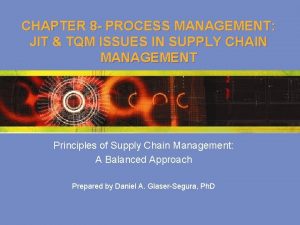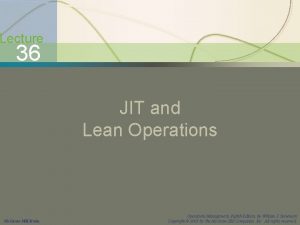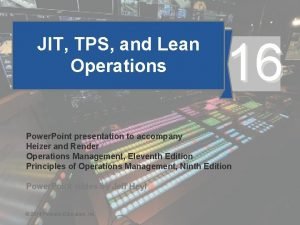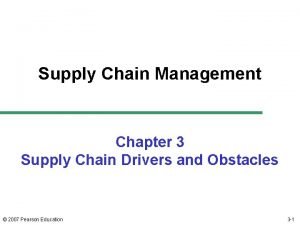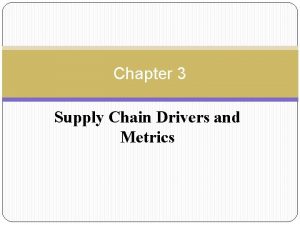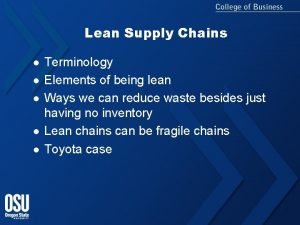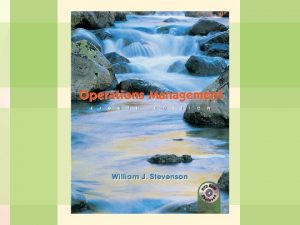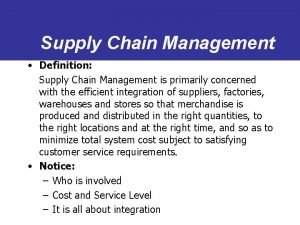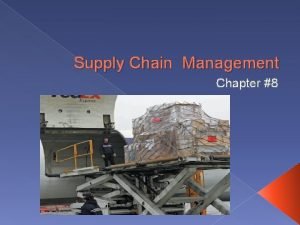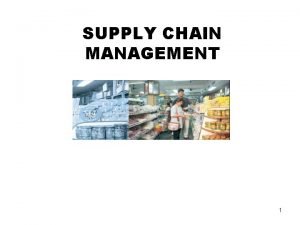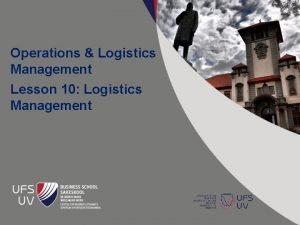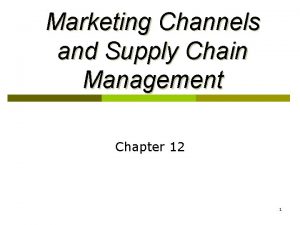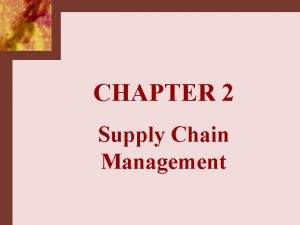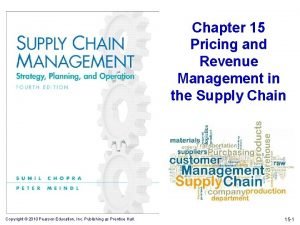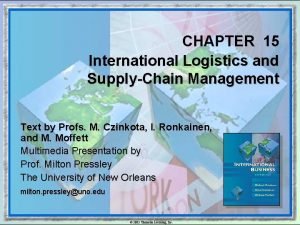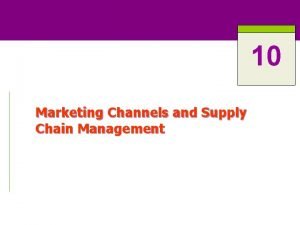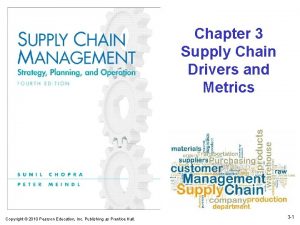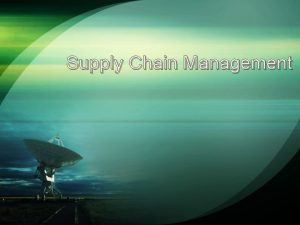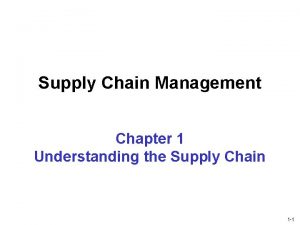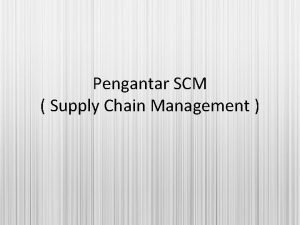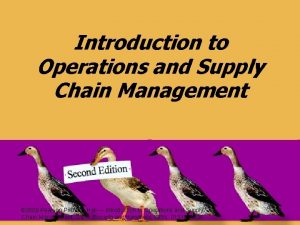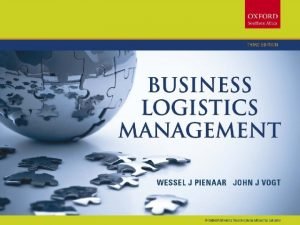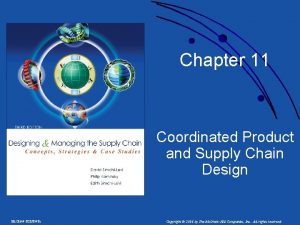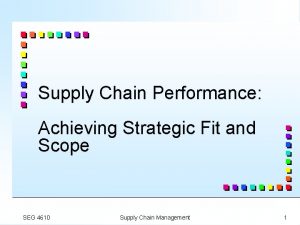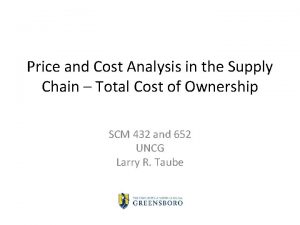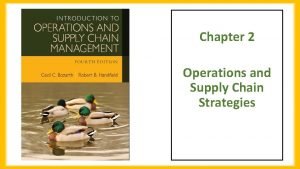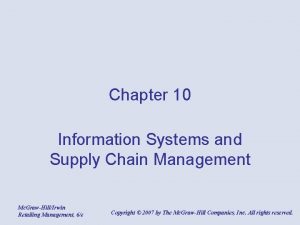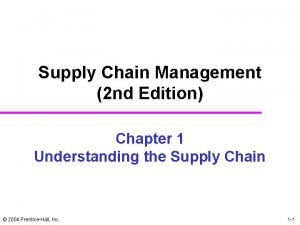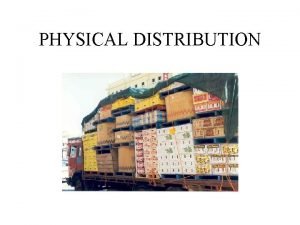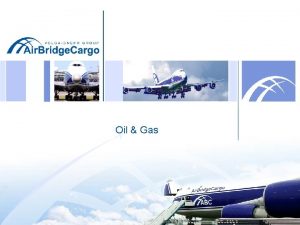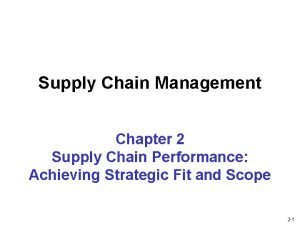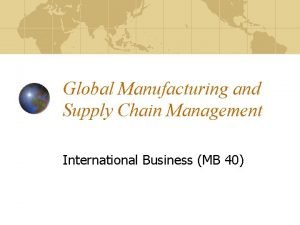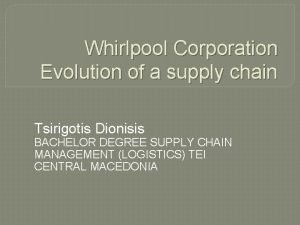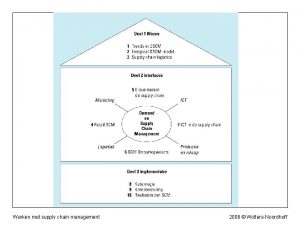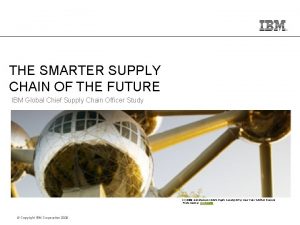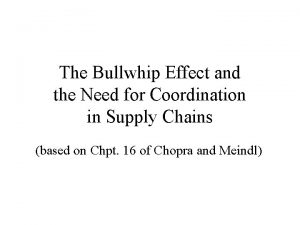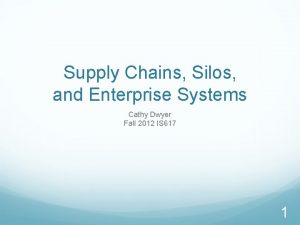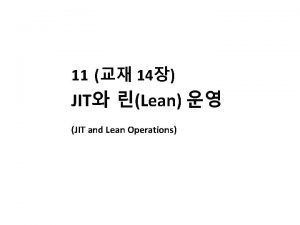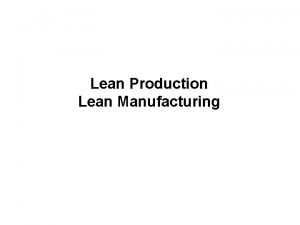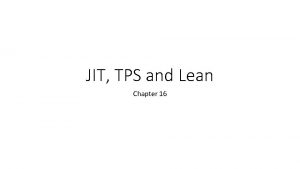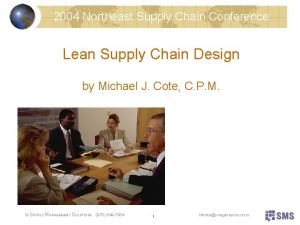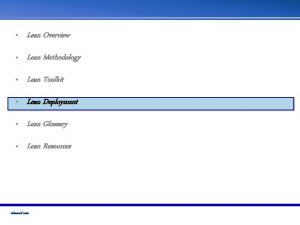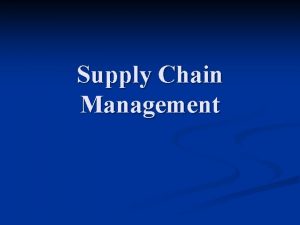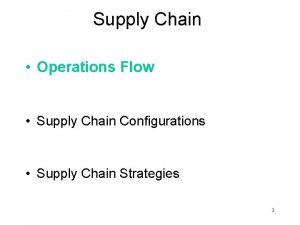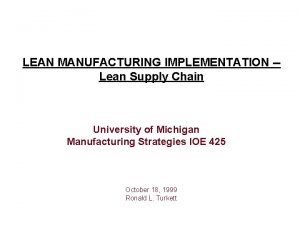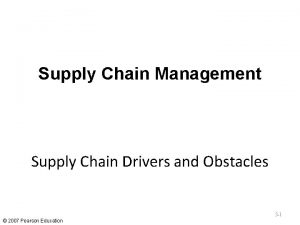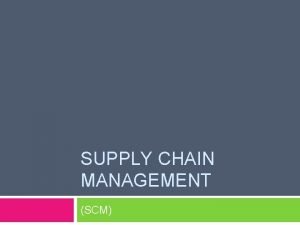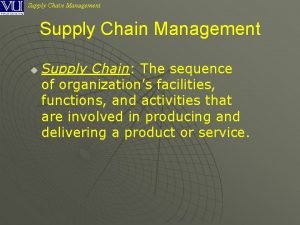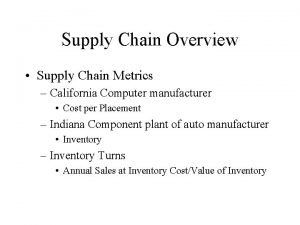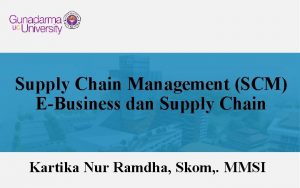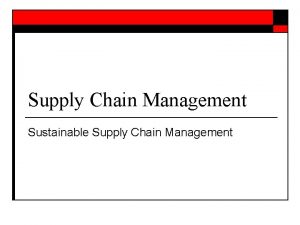JIT AND LEAN SUPPLY CHAIN JIT is a





























































- Slides: 61

JIT AND LEAN SUPPLY CHAIN

JIT is a manufacturing philosophy which aims at having the right part at precise right time and in the right quantity to go into assembly (Taiichi Ohno, 1982)

Important Characteristics of Lean Operations 1. Lean operation depends on having high-quality processes in place 2. Quality is an integral part of lean operation; without high process quality, lean operation cannot exist 3. A Central Theme for lean Operations is: - to work towards continual improvement of the system reducing inventories - Reducing setup cost and time - improving quality, increasing the output rate - and generally cutting waste and inefficiency

1. Manufacturing an item before it is required 2. Wasteful time incurred when product is not moved 3. Excessive movement and material handling of product between processes

4. Unnecessary Movement 5. Quality defects occur in rework and scrap and add wasteful cost to the system 6. Failure of the firm to learn from and capitalize on its employees knowledge and creativity

7. Using high precision equipments when simple machine would suffice 8. Excessive Inventory hides problems on the shop floor, consumes space, increase LT and inhibits communication

Lean-Focused Supply Chain Components Lean suppliers Able to respond to changes Lean procurement Lean Warehousing Lean logistics Optimized mode selection and pooling orders Key is automation Lower prices Higher quality Lean manufacturing Suppliers must see into the customers’ operations and customers must see into their suppliers’ operation Use pull and JIT concepts during the manufacturing Eliminate nonvalue-added steps and waste in storage process Lean customers Understand their business needs Combined multistop truckloads Value speed and flexibility Optimized routing Cross docking Establish effective partnerships with suppliers

Inventory Hides Problems

Benefits of Low inventories: ü It exposes problems of the system ü It tells you the niche area of the improvement ü It reduces cost ü Waste reduction and overall efficiency gets increased Example: As learned from Kawasaki plant in Nebraska they reduced their safety stock to 0 which exposed the problems at the plant like machine utilisation rate, conditions of the machine, errors in the products, excess waste etc. Helping them to identify the exact niche area where problems occur so that remedies were specific and controlled. After improvement inventory levels were mantained at optimum leading to better efficiency, less cost and reduced waste.

Example: Another example in service setting, managers commonly place stress on the system by reducing number of employees for a particular activity which slows the process and ultimately halts it, this problem can be identified before hand. If the working potential of employees is identified either you can give more load on the best employee or hire new employees thereby maintaining the quality and optimum quantity of manpower.

Supply Chain Considerations • Close supplier ties – Low levels of capacity slack or inventory – Look for ways to improve efficiency and reduce inventories throughout the supply chain – JIT II – In-plant representative – Benefits to both buyers and suppliers • Small Lot Sizes – – Reduce the average level of Inventory Pass through system faster Create uniform workload and prevent overproduction Increase setup frequency

Supply Chain Considerations • Close supplier ties – Low levels of capacity slack or inventory – Look for ways to improve efficiency and reduce inventories throughout the supply chain • JIT II – In-plant representative – Benefits to both buyers and suppliers

Process Considerations § Pull and Push method of Work § Quality at the Source: Jidoka § Uniform Work Stations: Heijunka

Jidoka Quality at source is extremely important because ü It reduces risks and ü Increase efficiency ü Reduces machine maintenance cost and generates Competitive advantage ü It also saves the company from legal hassle Example: In a bakery if you use a good quality butter it is not going to stick or damage your mixing machines leading to higher efficiency. Secondly, if regular cleaning of machines is performed it will save mantainenace cost, thirdly the product will be of higher quality and meet all the food safety standards generating Competitive advantage in terms of taste and standards

Example: There are several ways to maintain quality at source: Poka Yoke and Andon. Modern cars are equipped with signals for doors being opened during driving, alarm is triggered if the car is backing, lights or alarms trigger during emergency in order to avoid accidents.

Lean Concepts • Group technology: a philosophy in which similar parts are grouped into families • Eliminates movement and queue time between operations and reduces inventory Instead of specialized workcenters Group technology manufacturing cells

Lean Production Schedules Level schedule – pulls material into final assembly at a constant rate Freeze windows – the period of time during which the schedule is fixed and no further changes are possible Lean Backflush – calculation of how many of each part were required to produce the actual quantity of finished products built Uniform plant loading – smoothing the production flow to dampen schedule variation

Process Considerations Continued § Standardized components and work methods § Flexible workforce § Automation § 5 S Practices § Total Preventive Maintenance (TPM)

Process Considerations • Standardized components and work methods • Flexible workforce • Automation • Five S (5 S) practices • Total Preventive Maintenance (TPM)

Five S Method 5 S DEFINED 5 S Term 5 S Defined 1. Sort Separate needed from unneeded items (including tools, parts, materials, and paperwork), and discard the unneeded. 2. Straighten Neatly arrange what is left, with a place for everything and everything in its place. Organize the work area so that it is easy to find what is needed. 3. Shine Clean and wash the work area and make it shine. 4. Standardize Establish schedules and methods of performing the cleaning and sorting. Formalize the cleanliness that results from regularly doing the first three S practices so that perpetual cleanliness and a state of readiness are maintained. 5. Sustain Create discipline to perform the first four S practices, whereby everyone understands, obeys, and practices the rules when in the plant. Implement mechanisms to sustain the gains by involving people and recognizing them via a performance measurement system.

The Kanban System Receiving post Kanban card for product 1 Kanban card for product 2 Storag e area Empty containers Assembly line 1 O 2 O 1 Fabrication cell O 2 O 3 Assembly line 2 Full containers Single-Card Kanban System

The Kanban System Receiving post Kanban card for product 1 Kanban card for product 2 Storag e area Empty containers Assembly line 1 O 2 O 1 Fabrication cell O 2 O 3 Assembly line 2 Full containers

The Kanban System Receiving post Kanban card for product 1 Kanban card for product 2 Storag e area Empty containers Assembly line 1 O 2 O 1 Fabrication cell O 2 O 3 Assembly line 2 Full containers

The Kanban System Receiving post Kanban card for product 1 Kanban card for product 2 Storag e area Empty containers Assembly line 1 O 2 O 1 Fabrication cell O 2 O 3 Assembly line 2 Full containers

The Kanban System Receiving post Kanban card for product 1 Kanban card for product 2 Storag e area Empty containers Assembly line 1 O 2 O 1 Fabrication cell O 2 O 3 Assembly line 2 Full containers

The Kanban System Receiving post Kanban card for product 1 Kanban card for product 2 Storag e area Empty containers Assembly line 1 O 2 O 1 Fabrication cell O 2 O 3 Assembly line 2 Full containers

The Kanban System Receiving post Kanban card for product 1 Kanban card for product 2 Storag e area Empty containers Assembly line 1 O 2 O 1 Fabrication cell O 2 O 3 Assembly line 2 Full containers

The Kanban System: Overall Each container must have a card Assembly always withdraws from fabrication (pull system) Containers cannot be moved without a kanban Only good parts are passed along Production should not exceed authorization

Determining Number of Containers WIP = kc kc = d (w + p )(1 + α) k= c where k= d= w= p= c= α= number of containers expected daily demand for the part average waiting time average processing time number of units in each container policy variable

Determining Number of Containers ü The number of authorized containers in the TPS determines the amount of authorized inventory and management should make following determinations: i. The number of units to be held by each container and ii. The number of containers flowing back and forth between the supplier station and the user station. The number of containers flowing back and forth between 2 stations directly affects the quantities of WIP inventory, which covers any safety stock inventory to cover for unexpected requirements.

ü The containers spend some time in production, in a line waiting, in a storage location, or in transit. ü The key to determining the number of containers required is to estimate the average lead time required to produce a container of parts. ü The lead time is a function of processing time per container at the supplier station, the waiting time during the production process and the time required for materials handling. ü As per Little’s law, average WIP inventory equals the average demand rate multiplied by the average time a unit spends in the manufacturing process, can be used to determine the number of containers required to support the user station

WIP = (average demand rate) * (average time a container spends in the manufacturing process) + safety stock In this application, of determining the number of containers required for a part, WIP is the product of k the number of containers and c, the number of units in each container, consequently kc = d (w + p )(1 + α) k= c

Determining the Appropriate Number of Containers EXAMPLE 8. 1 • The Westerville Auto Parts Company produces rocker-arm assemblies • A container of parts spends 0. 02 day in processing and 0. 08 day in materials handling and waiting • Daily demand for the part is 2, 000 units • Safety stock equivalent of 10 percent of inventory a. If each container contains 22 parts, how many containers should be authorized? b. Suppose that a proposal to revise the plant layout would cut materials handling and waiting time per container to 0. 06 day. How many containers would be needed?

Determining the Appropriate Number of Containers SOLUTION a. If d= p= α= w= c= 2, 000 units/day, 0. 02 day, 0. 10, 0. 08 day, and 22 units 2, 000(0. 08 + 0. 02)(1. 10) k= 220 = 10 containers 22

AP-Exercise A company using a Kanban system has an inefficient machine group. For ex the daily demand for a part L 105 A is 3, 000 units. The average waiting time for a container of parts is. 8 day. The processing time for a container of L 105 A is. 2 day, and container holds 270 units. Currently 20 containers are used for this item. i. What is the value of policy variable, alpha ii. What is the total planned inventory (WIP and FG) for item L 105 A iii. Suppose, alpha is 0. How many containers would be required now? What is the effect of policy variable in this example.

d (w + p )(1 + α) k= c 20 = 3, 000 (. 8 +. 2) (1+ alpha) / 270 (1+ alpha) = 20 * 270 / 3000 * (. 8 +. 2) (1+ alpha) = 1. 8 Alpha =. 8 B. With 20 containers in the system and each container holding 270 units, the total Planned inventory is 20* 270 = 5400 units.

C If alpha is 0 k = 3, 000 (. 8 +. 2) (1+ 0) / 270 = 11. 11 or 12 containers The policy variable adjusts the number of containers. In this case, the difference is quite large as waiting time and processing time is fairly large and the number of units per container is small relative to daily demand.

Spradleys’ Sprockets d (w + p )(1 + α) k= c K = 52. 5

Lean Supply Chains Small specialized plants rather than large vertically integrated manufacturing facilities Specialized plants Can be constructed and operated more cheaply Important part of process Collaboration with suppliers Share projections with suppliers Link with suppliers online

Value must be defined jointly for each product family based on the customer’s perception. Building a Lean Supply Chain All firms along the value stream must make an adequate return on their investments. Firms must work together to eliminate waste (muda). When cost targets are met, firms will conduct new analyses to identify remaining waste and set new targets. Every participating firm has the right to examine every activity relevant to the value stream as part of the joint search for waste.

Value Stream Mapping (VSM) • • Value stream mapping is a qualitative lean tool for eliminating waste Creates a visual “map” of every process involved in the flow of materials and information in a product’s value chain Product family Current state drawing Future state drawing Work plan and implementatio n

Value Stream Mapping Selected Set of Value Stream Mapping Icons

Value Stream Mapping A Representative Current State Map for a Family of Retainers at a Bearings Manufacturing Company

House of Toyota • A key challenge is to bring underlying philosophy of lean to employees in an easy-to -understand fashion • The house conveys stability • The roof represents the primary goals of high quality, low cost, waste elimination, and short lead-times • The twin pillars, which supports the roof, represents JIT and Jidoka

House of Toyota Highest quality, lowest cost, shortest lead time by eliminating wasted time and activity Just in Time (JIT) § Pull system Culture of Continuous Improvement Jidoka § Manual or automatic line stop § Separate operator and machine activities § Error-proofing § Visual control Operational Stability Heijunka Standard Work TPM Supply Chain House of Toyota

AP # 3 You are asked to analyse the Kanban system of Lewin, a French manufacturer of gaming devices. One of the workstations feeding the assembly line produces part M 670 N. The daily demand for M 670 N is 1800 units. The average processing time per unit is. 003 day. Lewin record shows that the average container spends 1. 05 days waiting at the feeder workstation. The container for M 670 N can hold 300 units. 12 containers are authorized for the part. A. Find the value of the policy variable alpha B. Use the implied value of alpha from above to determine the required reduction in waiting time if one container was removed. Assume that all other parameters remain constant

Le. Win a Solving for implied policy variable, K =

Reduction in waiting time The reduction in waiting time is: = (1. 05 -. 888 ) / 1. 05 = 15. 43%

AP # 4 An assembly line requires 2 components: Gadjits and Widgets. Gadjits are produced by centre 1 and Widgets by centre 2. Each unit of the end item called a Jit together requires 3 Gadjits and 2 Widgets. The daily production quota on the assembly line is 800 Jit together. The container for Gadjits holds 80 units. The policy variable for centre 1 is set as 0. 09. The average waiting time for a container of Gadjits is 0. 09 day and 0. 06 day is required to produce a container. The container for Widgets holds 50 units and the policy variable for centre is. 08. The average waiting time per container of Widgets is. 14 day and the time required to process a container is. 20 day. A. How many containers are required for Gadjits B. How many containers are required for Widjits

J G (3) W (2)

Gadjits and Widjits Containers for gadjits K = K = 4. 905 or 5 Containers for widjits

K = 11. 750 or 12

Unsolved Qn The production schedule at Mazda calls for 1200 Mazda's to be produced during each of 22 production days in Jan and 900 Mazda's to be produced during each of 20 production days in Feb. Mazda uses a Kanban system to communicate with a nearby supplier of tires. Mazda purchases 4 tiers per vehicle from supplier. Safety stock policy variable is. 15. The container a delivery truck size is 200 tires. The average waiting time plus material handling time is. 16 day per container. Assembly lines are rebalanced at the beginning of each month. The avg. processing time per container in Jan. is. 10 day. Feb. processing time will average. 125 day per container. How many containers should be authorized for Jan? How many for Feb?

January’s container needs 7. 16 or 8 containers February’s container needs

(900*4) (0. 16+0. 125)(1+0. 15) 200 k = 5. 8995 or 6 containers per day

Unsolved Qn Markland first National bank of Rolla utilizes Kanban techniques in its check processing facility. The following information is known about the process. Each Kanban container can hold 50 cheques and spends 24 minutes a day in processing and 2 hours a day in materials handling and waiting. Finally the facility operates 24 hours per day and utilizes a policy variable for unforeseen contingencies of. 25. A. If there are 20 Kanban containers in use what is the current daily demand of the check processing facility? B. If the Muda or waste in system were eliminated completely, How many containers would there be required.

• Markland First National Bank • Processing time = 24 min/day Waiting time = 120 min/day Total processing and waiting = 144 min/day Total minutes per day = 24*60= 1440 Total processing and waiting in portions of a day = 144/1440 = 0. 10 Let d be the daily demand of checks [d(. 1)1. 25] = 20 50 d=8000 Checks

Waiting time is muda and therefore, if eliminated, would leave only 24 mins of processing time. When expressed as portions of a day, 24 min = 0. 017 days. (8000)(0. 017)(1. 25) = 3. 4 or 4 containers 50

Unsolved Qn Gestalt uses a Kanban system in its automobile facility in Germany. This facility operates 8 hour per day to produce the Jitter berg , a replacement for obsolete but fairly popular Jitney Beetle. Suppose that a certain part requires 150 seconds of processing at machine cell 33 B and a container of parts take overall 1. 6 hrs of waiting time there. Management allows a 10% buffer for unexpected occurrences. Each container holds 30 parts and 8 containers are authorized. How much daily demand can be satisfied with this system

Gestalt, Inc days 8 = 612

Videos to watch • https: //www. youtube. com/watch? v=o. Zy. TT 9 u r. RM 0&t=582 s (Lean in Services) • https: //www. youtube. com/watch? v=c 0 Qxa. Yior 0 (Learn what is 5 S and how it applies to any Industry) • https: //www. youtube. com/watch? v=z. UUVy 59 J_54 (Intro – Lean Manufacturing)
 Process management in tqm
Process management in tqm Jit and lean manufacturing
Jit and lean manufacturing Jit scheduling tactics
Jit scheduling tactics Chapter 3 supply chain drivers and metrics
Chapter 3 supply chain drivers and metrics Lean warehousing principles
Lean warehousing principles What is supply chain drivers
What is supply chain drivers Elements of lean supply chain
Elements of lean supply chain Lean operational management
Lean operational management Matching supply and demand in supply chain
Matching supply and demand in supply chain Value chain and supply chain difference
Value chain and supply chain difference Food chain sequence
Food chain sequence Chapter 5 section 1 supply
Chapter 5 section 1 supply Supply chain management definition
Supply chain management definition Supply chain upstream and downstream
Supply chain upstream and downstream Replenishment cycle in supply chain
Replenishment cycle in supply chain Introduction to operations and supply chain management
Introduction to operations and supply chain management Conventional marketing system
Conventional marketing system Marketing channels and supply chain management
Marketing channels and supply chain management Functional component of ecrm
Functional component of ecrm Total cost concept in supply chain management
Total cost concept in supply chain management Role of pricing and revenue management in a supply chain
Role of pricing and revenue management in a supply chain International logistics and supply chain outsourcing
International logistics and supply chain outsourcing Facility related metrics
Facility related metrics Role of pricing and revenue management in a supply chain
Role of pricing and revenue management in a supply chain Exclusive vs selective distribution
Exclusive vs selective distribution Functional vs innovative products
Functional vs innovative products Fcsd packaging and shipping guide
Fcsd packaging and shipping guide Supply chain drivers and metrics
Supply chain drivers and metrics Ppt index
Ppt index Scm 1
Scm 1 Scm cycle view
Scm cycle view Supply chain drivers and obstacles
Supply chain drivers and obstacles Introduction to operations and supply chain management
Introduction to operations and supply chain management Global logistics and supply chain strategy
Global logistics and supply chain strategy Logistics supply chain strategy and planning
Logistics supply chain strategy and planning Coordinated product and supply chain design
Coordinated product and supply chain design Zone of strategic fit in supply chain
Zone of strategic fit in supply chain Markov chain operations research
Markov chain operations research Price and cost analysis in supply chain
Price and cost analysis in supply chain Single channel distribution
Single channel distribution Structural and infrastructural elements in supply chain
Structural and infrastructural elements in supply chain Information system and supply chain management in retailing
Information system and supply chain management in retailing Cycle view
Cycle view Logistics and supply chain management
Logistics and supply chain management Oil and gas supply chain challenges
Oil and gas supply chain challenges Implied uncertainty spectrum
Implied uncertainty spectrum Revenue management and pricing
Revenue management and pricing Global manufacturing and supply chain management
Global manufacturing and supply chain management What are the inputs to and outputs of a supply chain
What are the inputs to and outputs of a supply chain Open chain exercises
Open chain exercises Elastisidad ng suplay
Elastisidad ng suplay Whirlpool supply chain
Whirlpool supply chain Werken met supply chain management noordhoff
Werken met supply chain management noordhoff Supply chain lci
Supply chain lci Ibm smart supply chain
Ibm smart supply chain Pipeline in supply chain
Pipeline in supply chain Behavioral obstacles in supply chain
Behavioral obstacles in supply chain Silos in supply chain
Silos in supply chain Supply chain risk register
Supply chain risk register Supply chain risk management framework
Supply chain risk management framework Supply chain risk management framework
Supply chain risk management framework Risk assessment likelihood
Risk assessment likelihood
